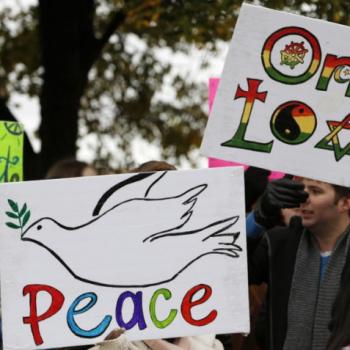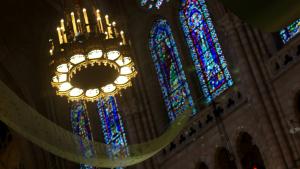This is part 3 of a 4 part series on Baptists, recorded by video for an instructional curriculum on mainstream Protestants over at this cool new online learning site for churches, ChurchNext (I know, I’m as surprised as you are that we made the mainstream list). So much thanks to friend, teacher, mentor, superstar Dr. Rosalie Beck, for her help remembering what I learned in class 25 years ago. Any inadvertent misinformation here is all mine, not hers!
Have you ever been to the M&M store on Times Square in New York City, looked around and taken in all the different colors of M&Ms lining the walls? That would be a experiential metaphor for Baptist life. There are so many different shades of Baptist, it’s hard to get a clear snapshot that includes everyone. But I’m going to try to give you some sense here about different kinds of Baptists.
But before we do that, you have to remember this: Baptists have traditionally built communities around shared concerns. These concerns are sometimes theological—like Baptist groups that have formed to do snake handling or teach Calvinism. But many times these concerns are practical—like missions support, or abolition, or prohibition, or the inclusion (or exclusion, for that matter) of the LGBTQ community.
 Because Baptists are noncreedal—they don’t adhere to prescribed statements of faith or coerce agreement—Baptists are perpetually reinventing themselves in different variations. For example, you might remember that the very first Baptists divided into two groups over the theological issue of Calvinism: not long after Baptists began there were General Baptists, who believed in God’s free grace available to all, and Particular Baptists, who believed God chose and preordained salvation ahead of time.
Because Baptists are noncreedal—they don’t adhere to prescribed statements of faith or coerce agreement—Baptists are perpetually reinventing themselves in different variations. For example, you might remember that the very first Baptists divided into two groups over the theological issue of Calvinism: not long after Baptists began there were General Baptists, who believed in God’s free grace available to all, and Particular Baptists, who believed God chose and preordained salvation ahead of time.
This variety of expression is just part of being Baptist, because Baptists hold to the firm conviction that adults make voluntary spiritual decisions, and that everyone can be led and inspired by God. And remember, there’s no hierarchy chiming in on boundaries for belief; unlike the United Methodist Church or the Evangelical Lutheran Church of America or the Presbyterian Church, USA…there is no “The Baptist Church.” No umbrella group speaks for all; the only “Baptist church” there is is the one on the corner.
In Baptist life in America two early trends emerged. There were Baptists who came out of a Puritan background—those folks who came directly out of that English Baptist beginning. They were largely ex-congregationalists whose leaders were less formally trained. Membership in this group, the Separate Baptists, began to gain traction during the First Great Awakening in the mid 1700s. A second trend was the Charleston Baptists who settled down South and began a tradition of high intellectual standards and thoughtful faith expression. You might recognize some names from this group, names like Mercer and Furman.
As American history unfolded, it was the Separate Baptists—that northern, former Puritan bunch, that came to dominate the American Baptist landscape. For a group that valued independence and openness to the new work of God’s Spirit, the responsibility and obligation of every adult to respond to the question of faith…well, the cultural atmosphere in this new and growing country was a perfect fit, and Baptists thrived. Just think about it running parallel to American history: Baptists, along with other religious expressions, blossomed during the First and Second Great Awakenings—where the work of God’s Spirit was emphasized. As the West was being settled, the model of Farmer/Preacher became popular: perfect for a denomination that doesn’t traditionally require formal theological training for pastors! Baptists grew stronger and bigger during the Industrial Revolution, where communities formed around advocacy—a great match for Baptist tradition and polity. In other words, young America was a perfect climate for Baptists to grow.
Things really started changing on the Baptist landscape when two young Congregational missionaries, Anne and Adoniram Judson, set out for India in 1812. On their long trip to India they spent a lot of time reading the Bible and thinking about baptism, the end result of which was that they landed in India, Baptists. Since The Judsons were already over on that side of the world, Baptists in America organized to take over their support and they settled in Rangoon, Burma and became the very first Baptist missionaries. With that, Baptists were off and running on an issue that would define them: missions. Baptists began organizing at county, state, and national levels to cooperatively support missions.
That went along fine until 1845, when Baptists split along geographical lines. You might recall a little bit of controversy was beginning to heat up in our country around then. Baptists in the North, opposed to slavery, would not appoint any missionaries from the South who owned slaves. So Baptists split along north and south lines. Almost every other major American denomination split over this issue, too. Baptists, however, are the only ones who have not come back together, and the resulting two groups are the largest and most well-known Baptist groups in this country: the Southern Baptist Convention and American Baptist Churches, USA.
But there are more—in fact, there are over 200 identified different kinds of Baptists in America. We vary from Rick Warren’s huge Saddleback Church in California to little country churches in the middle of nowhere. And Baptists all over the world echo that variety. You can find Baptist churches that handle snakes, use incense in worship, identify themselves as Appalachian Fundamentalist Universalist Baptists. We’ve got Baptists who ordain women as a matter of course and those for whom women in any form of leadership is an anathema. We claim churches like Hell Hole Swamp Baptist Church in South Carolina and Harmony Baptist Church in East Texas—just a half mile away from Harmony Baptist Church #2.
We’re known in recent years for the exclusive public positions of Southern Baptist Convention leaders and the hate-filled protests of the folks over at Westboro Baptist Church. And we’re also known for leaders like: Walter Rauschenbusch, Clarence Jordan, Martin Luther King, Jr., William Sloane Coffin, and Jimmy Carter, and churches that speak and act prophetically to welcome those others would exclude and to start movements that shift society and heal the world.
Here’s the thing about what it means to be Baptist: when you cast the net wide and leave the borders open, the variety that results is vast and a bit messy. In and among that variety is much that troubles. And in and among that variety we can also see so clearly the transforming and beautiful work of the Spirit of God.











